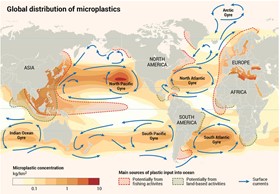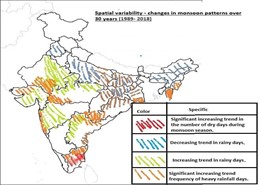07 Aug
Water crisis due to unsustainable agricultural practices
Introduction
Unsustainable agricultural water use practices threaten the sustainability of livelihoods dependent on water and agriculture. Agriculture, encompassing crops, livestock, fisheries, aquaculture, and forestry, is both a cause and a victim of water scarcity. It accounts for the bulk of global water withdrawals. Farming accounts for almost 70 percent of all water withdrawals, and up to 95 percent in some developing countries.
The global water footprint related to crop production
- According to the study published by UNESCO-IHE Institute for Water Education, the global water footprint related to crop production in the period 1996-2005 was 7404 billion cubic meters per year (78% green, 12% blue, 10% grey).
- Wheat and rice have the largest blue water footprints, together accounting for 45% of the global blue water footprint.
- At country level, the total water footprint was largest for India, China, and the USA. A relatively large total blue water footprint because of crop production is observed in the Indus River basin and the Ganges River basin. The two basins together account for 25% of the blue water footprint related to global crop production.
- Globally, rain-fed agriculture has a water footprint more than double that of irrigated agriculture.
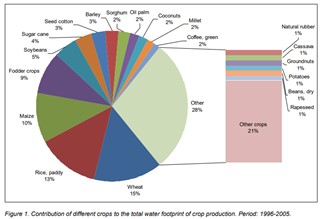

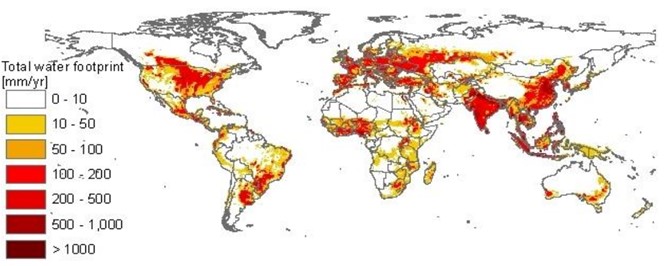
The data are shown in mm/yr and have been calculated as the aggregated water footprint per grid cell (in m3 /yr) divided by the area of the grid cell. Period: 1996-2005.
How does agriculture promote water crisis?
- Unsustainable Cropping Patterns: The choice of crop greatly impacts the amount of water that is needed. Consider the production of water-thirsty crops like paddy and sugar cane in the Punjab-Haryana belt and Maharashtra, respectively. There is a serious mismatch between the cropping pattern of these crops and water resource availability in the states growing them.
- Intensive monoculture is putting water systems in peril: Plant uniformity in highly managed landscapes that have replaced wetlands, for example, has been linked to increases in the frequency and severity of both floods and droughts, as well as the deterioration of water quality. Elsewhere, the growth of maize monocultures to produce ethanol and biodiesel in the United States are projected to increase areas at risk of groundwater nitrate contamination. And tree plantations grown to meet the demand for wood can reduce or even eliminate streams, leading to soils becoming more acidic or salinated and with increased susceptibility to fire.
- Unsustainable irrigation practices: Agriculture strongly relies on irrigation. While irrigated land accounts for roughly 20% of the global cultivated area, it contributes to about 40% of crop production. In the last few decades, the growing demand for agricultural commodities has translated into an increasing pressure on the global freshwater resources, often leading to their unsustainable use. 40 to 50 per cent of global irrigation practices are unsustainable because they deplete environmental flows and/or groundwater stocks. E.g., Flood irrigation is quite inefficient as only 40-60% of the water is actually utilized by the crops.
- Water Export: 15% of Unsustainable irrigation water consumption (UWC) is virtually exported, with an average 18% increase between year 2000 and 2015. About 60% of global virtual transfers of UWC are driven by exports of cotton, sugar cane, fruits, and vegetables. One third of UWC in Mexico, Spain, Turkmenistan, South Africa, Morocco, and Australia is associated with demand from the export markets. The globalization of water through trade contributes to running rivers dry, an environmental externality commonly overlooked by trade policies.
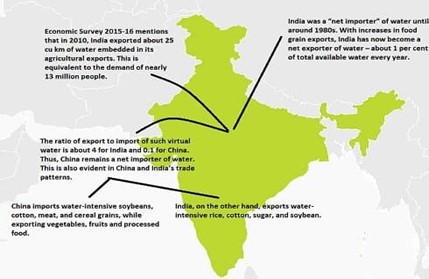
- Case Study: India, a water scarce country, has been “exporting water” because of distorted incentives. Economic Survey 2015-16 mentions that in 2010, India exported about 25 cu km of water embedded in its agricultural exports. This is equivalent to the demand of nearly 13 million people.
- Water Pollution: Agriculture plays a major role in water pollution. Farms discharge large quantities of agrochemicals, organic matter, drug residues, sediments, and saline drainage into water bodies. Nitrate from agriculture is now the most common chemical contaminant in the world’s groundwater aquifers. The livestock sector is growing and intensifying faster than crop production in almost all countries. The associated waste, including manure, has serious implications for water quality.
- Emerging forces
- Climate change will have significant impacts on agriculture by increasing water demand, limiting crop productivity, and reducing water availability in areas where irrigation is most needed or has a comparative advantage. A growing number of regions will face increasing water scarcity. Climate change will bring greater variation in weather events, more frequent weather extremes, and new challenges.
- Globalization continues over the long run, providing new opportunities for commercial and high-value agriculture but presenting new challenges for rural development. Urbanization increases demand for water, generates more wastewater, and alters patterns of demand for agricultural products. Greater reliance on bioenergy will affect the production and prices of food crops and increase the amount of water used by agriculture.
Practical Challenges for Water Management in Agriculture
- The ability to improve water management in agriculture is typically constrained by inadequate policies, major institutional under-performance, and financing limitations.
- Government incentives, such as the sugar mill build-up in Marathwada to replicate the prosperity created by mills in other areas, as well as assured markets for crops like paddy and sugarcane through procurement (Minimum Support Price and Fair Remunerative Price), have led to farmers cultivating these water-guzzling crops, despite the water-scarce nature of these regions. Environmentalists have often argued that sugar cane is the cause of chronic drought in Marathwada (Maharashtra). The NABARD-ICRIER report also makes an argument for moving such high water-reliant crops to other, relatively water-abundant areas.
Way Forward
- Improve water productivity: There is great opportunity to improve water productivity through improving yield levels as much as four folds within the available water balance in rain-fed agriculture. This offers a good opportunity to increase food production from rain-fed agriculture by raising water productivity without requiring additional blue water resources. However, in semi-arid and arid regions the available precipitation is quite low and crop production without additional use of blue water is almost impossible. Globally, the current cereal production would be significantly lower if no blue water is applied. Therefore, a carefully balanced green-blue water use strategy would be required to address the issue of increasing water demand in a world of limited freshwater resources.
- Crop diversification as per agroecology: Crop diversification can lead to several benefits like conservation of groundwater, revitalization of soil leading to improved productivity and efficient use of resources, strengthening of the rural sector by increasing employment opportunities and ecological gains through sustainable agricultural practices.
- Watershed Management: Water characteristics like inflows (precipitation, surface water inflow, ground water inflow) water use (evaporation, evapotranspiration, irrigation, drinking water) outflows (surface water outflow, ground water out flow) storage (surface storage, ground water storage, root zone storage) are the principal factors to be taken care of in sustainable water management. The broad interventions for water management are Rainwater Harvesting, Ground Water Recharge, Maintenance of Water Balance, Preventing Water Pollution and Economic use of water.
- Adopt micro irrigation methods: Micro irrigation is known to vastly reduce the amount of water needed for irrigating crops. For example, sprinkler irrigation uses 30 to 40 percent less water, while drip irrigation uses about 40 to 60 percent less water as compared to flood irrigation. There is a 40 to 50 percent gain in productivity due to the use of micro-irrigation. Realising its potential, in India the Pradhan Mantri Krishi Sinchayee Yojana was enforced in 2014 with the objective of ‘more crop per drop’.
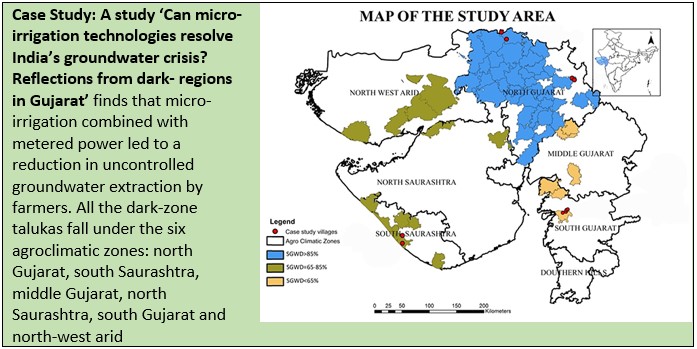
- Replacing animal-based food products with the nutritionally equivalent plant-based products will reduce the WF of consumption.
Given the existing constraints above, the agricultural water management sector is currently in the process of repositioning itself towards modern and sustainable service provision. It proposes a singular water approach on building resilient water services and sustaining water resources, while also managing risks related to broader social and economic water-related impacts. This includes transforming governance and service provision as well as supporting watershed management and greening the sector and can be achieved by providing improved incentives for innovation, reforms, and accountability.
Geo-textiles And Environment Conservation
- Why in news: National Rural Infrastructure Development Agency (NRIDA) has announced that coir geo-textiles will be used for construction of rural roads under the Pradhan Mantri Gram Sadak Yojana.
- Background: Geo-textiles: They are permeable fabrics which, when used in association with soil, have the ability to separate, filter, reinforce, protect, or drain.
- Based on their function they can be of three types:
- Woven geo-textile (resembling mail bag sacks).
- Non-woven geo-textile: Needle punched (resembling felt) or heat bonded (resembling ironed felt).
- Coir geo-textile (Bhoovastra): are made from coconut fibre extracted from the husk of coconut.

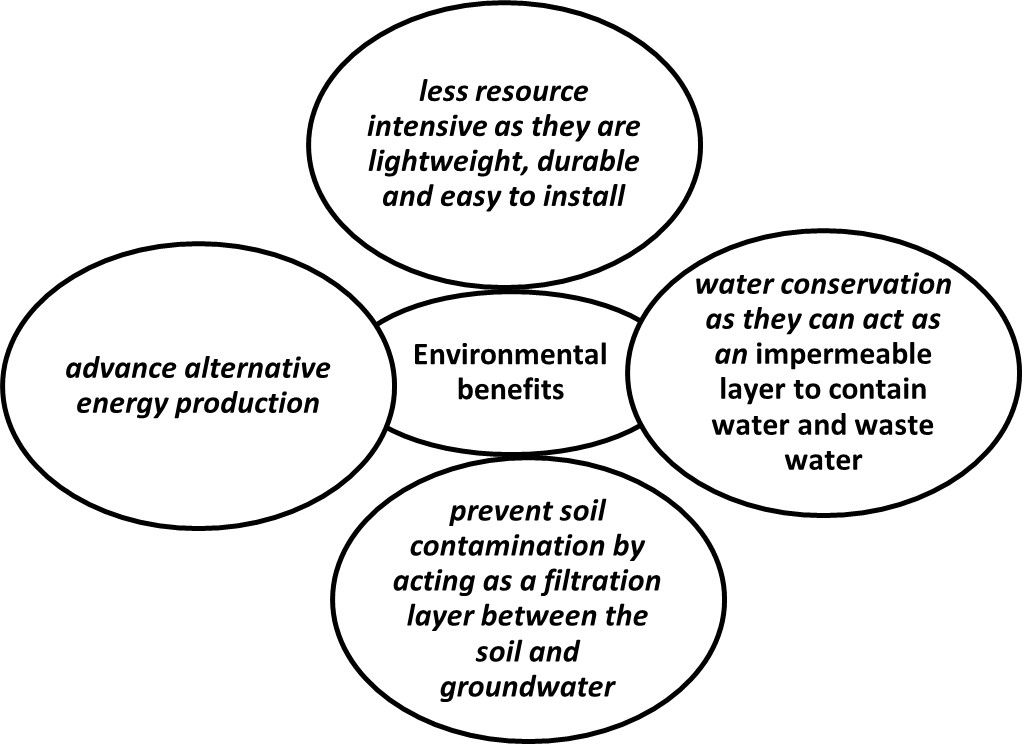
- Environmental Conservation with Geo-textiles: With use of indigenous materials, they could be effective, affordable and compatible with sustainable management.
- Soil Conservation: Geo-textile can be used as an effective tool for.
- Slope protection: Stabilization of slope soil to check sediment loss especially in the hilly terrains. Can be used in landslide prone regions of India - North East Himalaya, North West Himalaya), Western Ghats and Konkan hills and in Eastern Ghats of Aruku area .
- Geo-textile bags also called geo-bags can be used to make river bunds to check flooding and soil erosion.

- Water pollution control and conservation:
- Help separation of sediment particles while allowing water drainage from its surface.
- Can be used in the sub-soil layer to check leaching and underground water pollution.
- These Sheets are also used to cover lakes- help in reducing evaporation related water loss as well as check influx of pollutants.
- Check Coastal Erosion: to create a synthetic barrier along shorelines and beaches to help control erosion. It acts as the first line of defence against waves and tidal action.
- Geo-textiles for sustainable development: act as liquid and gas barrier that performs filtration and retention mechanism and help in structural reinforcement. Thus can be used as base material to provide strength and structure to infrastructure development and can help ensure environmental sustainability.
Case Study: Bhoovastra - Kerala has taken the lead being a major Coconut producer
The Coir geo-textiles are also called Coir Bhoovastra used to :
-
- Cover slopes, streams bunds, canals and river banks and they proved to be great for slope-stabilisation.
- Geo textiles have open cells which collect the disturbed soil and act as check dams ensuring soil erosion control.
- Also acts as a mulch and provide enrichment to the soil.

- Geo-textilesare one of the fastest growing sectors of the technical textile market, which is expected to keep growing in the future, but the use of natural fibres should not be ignored especially in developing countries like India.
- The standardisation of certain properties of geo-textiles and test methods will deliver more reliable technical data and design methodology for woven geo-textiles.
- Where can we use it:
- Geography: P1- biogeo (soil conservation), envi geo (conservation and sustainable dev), settlement (urbanisation problems and remedies). P2- regional dev (hill area dev), industries, contemporary issues ( hazard management).
- GS: P3 (environment conservation and disaster management).
Links
Prospects of Hydrogen in India
- In news: Oilfields (Regulation and Development) Amendment Bill 2021 proposes to amend the Oilfields (Regulation & Development) Act 1948 which deals with 'mineral oils' as understood in the conventional sense. It proposes a new definition of 'mineral oils' by including within its ambit modern and cleaner sources of energy like hydrogen.
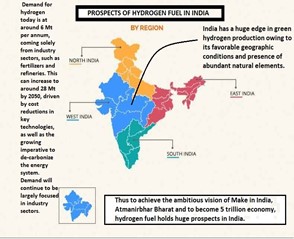

- Prospects of hydrogen fuel in India: According to GoI, 70 per cent of green hydrogen production costs come from electricity, hence, surplus electricity from renewable energy sources can enhance green hydrogen production economics with following prospects:
- Prospect for hybrid energy generation: With the large solar, wind, hydro, and waste potential in India, the country can lead the world in Hydrogen-Based Hybrid Energy production. Example: Hybrid system including photovoltaic (PVs) and hydrogen fuel cell.
- Prospects for employment generation: Hydrogen ecosystem can create a USD 20-billion green technology market in India and will enhance domestic job creation.
- Green hydrogen will help India achieve its carbon neutral target and help fulfill INDC, leading through sustainable and climate-neutral development.
- Green hydrogen has prospects to be an ideal power source for energy-intensive industries like refining, steel, cement, fertilizer, mining, industrial heating marine and aviation applications.
- India can be seen as a net exporter of hydrogen in the future to European, Southeast Asian countries, and Africa and will reduce import dependence of India on fossil fuels.
- Prospects for use in remote areas development: The availability of hydrogen based on local sources and generation could prove to be an alternative to diesel-based power and heating in remote areas. This will reduce the need to transport fuels and improve the lives of those living in distant regions by offering a non-polluting fuel.
Case Study: Ladakh, which depend on outside sources for transportation fuel, has signed an agreement with the NTPC Ltd for a pilot project of hydrogen gas-powered transport buses. This will not only ensure development and energy security in remote hilly areas but also help better mobilization of forces in border areas and protect the fragile ecology of the region.
- Hydrogen as renewable and readily available energy:
- Hydrogen is the most abundant element in the Universe and renewable source of energy, provides three times more energy than fossil fuels and releases pure water as the only byproduct.
- More Powerful and Energy Efficient: Hydrogen has the highest energy content of any common fuel by weight, thus prospects for being a cost-efficient, effective and long-term alternative to fossil fuels.
- Challenges associated: The development of hydrogen fuel cell technology in India is in the prenatal stage, despite the country being one of the major automobile markets in the world.
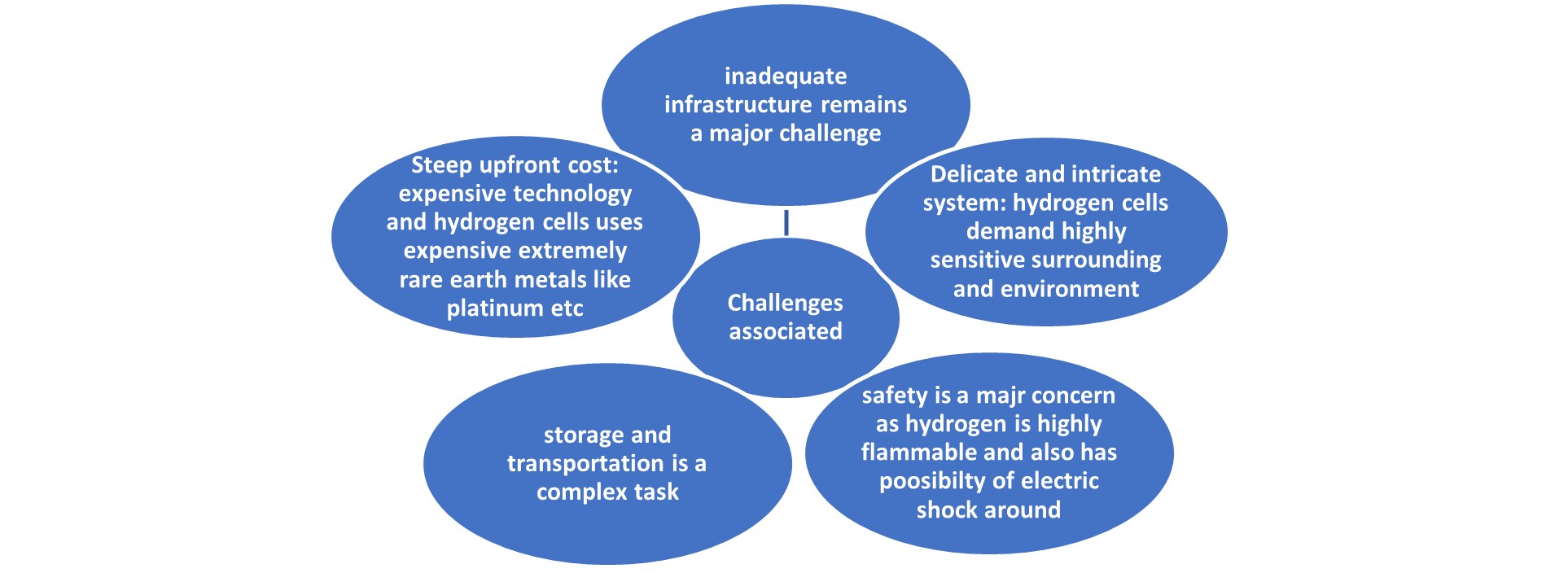
- Way forward:
- To ensure low carbon hydrogen is favored over high emission alternatives, an emissions penalty could be introduced on fossil fuel to make it costlier and to support demand of green product, standardization of such products should be introduced.
- Government of India recently announced the National Hydrogen Mission in the Union Budget 2021 for making a hydrogen roadmap for the country.
- Where can we use it:
Geography: P1: climatology (climate change), economic geo (LTG, energy crises), regional development and planning.
P2: Resources (Energy resources), regional development and planning, contemporary issues.
GS: P3 (infrastructure: energy security).
Shield Volcano
- Shield volcanoes form when a centralized vent produces low-viscosity flows over a long period of time (Walker, 2000).
- They mostly comprise of basaltic lavas, leading to formation of gentle slopes ;though higher silica peralkaline lavas may also be present.
- Some of the famous shield volcanoes are : Mauna Loa (Hawaii); Kilauea (Hawaii); Fernandina Island (Galapagos Islands).
- Fernandina Island is an active shield volcano in the Galapagos Islands.
- Recently in news for the lava eruption on March 2021 in the Geldingadalur region of Iceland's Reykjanes Peninsula.
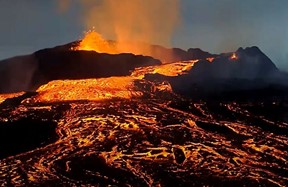
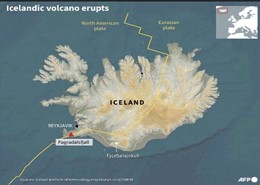
Shola forest
- Derived its name from the Tamil word solai, Shola forest refers to stunted tropical montane forest which is found in the valleys in between the grassland in the higher montane regions of south of India at an altitude of 1500 metres.
- The trees have stunted growth due to wind action with spreading canopy, twiggy branchlets and foliage of different colours.
- Strobilanthes Kunthiana, also known as Neelakurinji and Kurinji in Malayalam and Tamil, it is the most celebrated shrub found in these forest. They need about 12 years for flowering.
- They are found in the upper reaches of the Nilgiris, Palni hills, Anamalais, Kalakadu, Mundanthurai and Kanyakumari in the states of Tamil Nadu and Kerala.
- The common fauna found is the Nilgiri tahr, an endangered species which is protected at the Eravikulam National Park.
- Other species include Nilgiri langur, slender loris, sambar deer, etc.
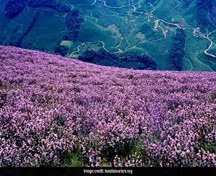

Aeroponics
- It is an indoor farming technique in which plants grow in a controlled environment that is free from soil or any other aggregate media.
- How do they work? In Aeroponic systems seeds are planted in pieces of foam stuffed into tiny pots, which are exposed to light on one end & nutrient mist on the other. The foam holds the stem and roots in place as the plants grow. Roots hang suspended in the air while a nutrient solution is sprayed as a fine mist.
- Advantages: this system does not require much land and can be setup in vertical manner, 98% reduction in water usage, 60 % reduction in fertilizer usage, pesticides are fully eliminated as the absence of soil reduces chances of diseases, will cut down the environmental cost of getting food from field to plate and very much useful for resource strained countries like Japan and Singapore.
- In India, the central potato research institute earlier this year, started growing mini-tubers (seed potatoes) through Aeroponics with a capacity to grow 1 million mini tubers every 3 months.
- Concerns: Highly expensive, technology intensive, crops get effected even if there is a 15 minute disruption in electricity supply and preparing the nutrient solution varies from crop to crop & also depends on location and quality of water available.
Flood Management: Mozambique
Background: According to the World Bank report, Mozambique, a country in the southeastern Africa experienced 12 major floods, 9 major droughts and 4 major cyclone events between 1965 and 1998. Here the case study includes the catastrophic floods occurred in 2000 and 2007 & how several measures taken by Mozambique led to efficient flood management.
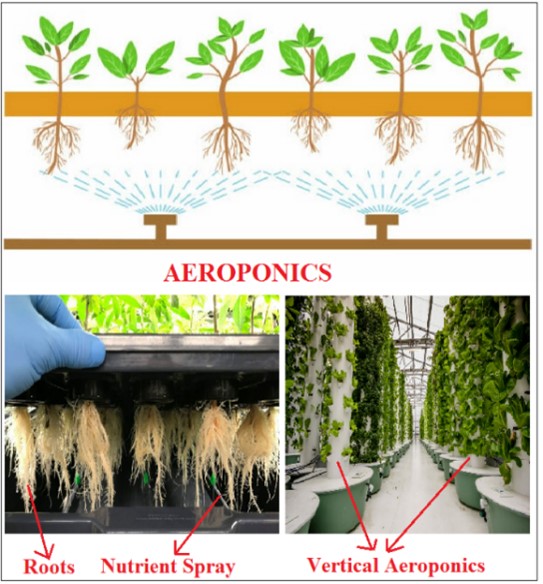
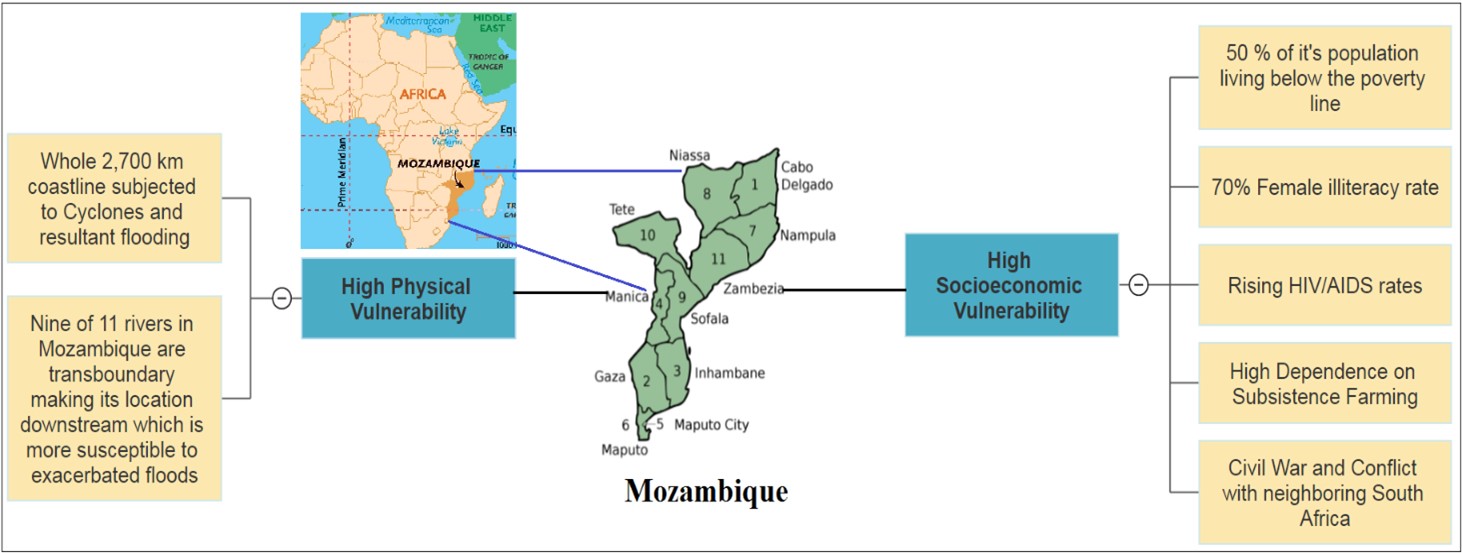

This can be replicated in countries threatened by sea level rise and which experience frequent floods.
Where this Case Study can be used?
This case study can be used in topics related to Paper 1 (Tropical Cyclones, Environmental Hazards, Migration, Problems of Urbanization), Paper 2(Tropical Cyclones, Floods, Urban problems, Disaster Management).
Places in news
|
Chiplun:
|
|
Asan Conservation Reserve:
|
|
Puga village:
|
|
Bamuni Hills:
|
|
Channapatna:
|
|
Araku valley:
|
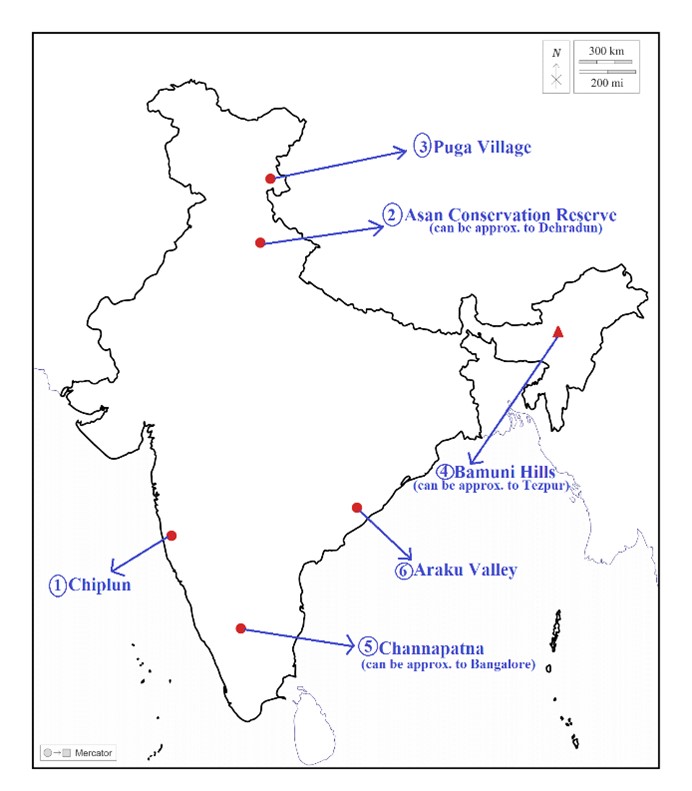
Share the article
Get Latest Updates on Offers, Event dates, and free Mentorship sessions.

Get in touch with our Expert Academic Counsellors 👋
FAQs
Geography Current Affairs focuses on the contemporary issues, events, and developments in the field of geography. It covers recent geographical phenomena, environmental changes, geopolitical shifts, and related news. This differs from regular geography studies which may focus more on foundational concepts, historical contexts, and theoretical frameworks.
Updates are provided regularly to ensure that subscribers stay informed about the latest developments in geography. Typically, updates are provided on a fortnightly basis, depending on the frequency of significant events and changes in the field.
Absolutely. Geography Current Affairs serves as a valuable resource not only for Geography optional but also for GS papers, especially GS Paper 1 (covering Indian Heritage and Culture, History, and Geography of the World and Society) and GS Paper 3 (covering Technology, Economic Development, Biodiversity, Environment, Security, and Disaster Management). It aids in building a holistic understanding of various topics and strengthens answer-writing skills by incorporating contemporary examples and perspectives.
Geography Current Affairs holds immense importance for UPSC preparation, particularly for aspirants opting for Geography optional. It helps candidates stay updated with the latest developments, geographical phenomena, environmental issues, and geopolitical shifts worldwide, aligning them with the dynamic nature of the subject as tested in the UPSC examinations.

